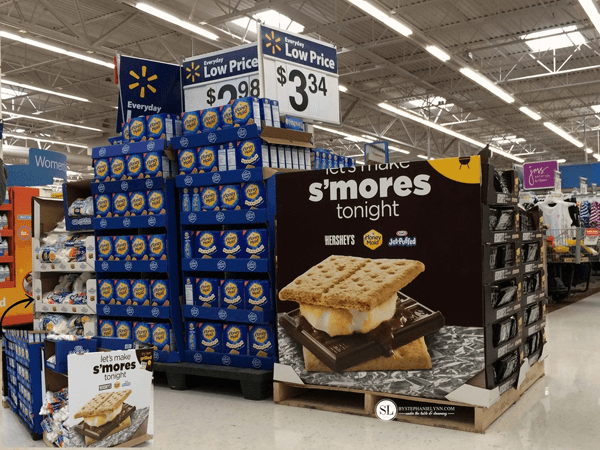Wal-Mart: The Ultimate Silo and Content Ideation Template

A proper internal linking structure can benefit your website and business in more than one way. If a site visitor engages with a great piece of content that in turn links to related resources, they are going to stick around longer. The more time they spend on your site, the more likely they are to convert. In addition to user engagement, proper internal linking can also improve your visibility in search.
The topic of internal linking can be somewhat confusing, especially if you are a less experienced marketer. Today we are going to simplify the process so that you can set up your site to perform optimally and as a bonus, you will also generate some new content ideas in the process.
The Grocery Store Formula
Close your eyes for just a moment and picture an aisle at Wal-Mart (or your favorite grocery store) and think about how items are organized. Each aisle or display is organized using:
- Related Items from the Same Top-Level Category (crackers)
- Items That Are Used Together to Create a Finished Product (marshmallows, chocolate, and graham crackers)
- Items That Shoppers Use Concurrently (charcoal, lighter fluid, tongs for the grill)
If we take a closer look at each, you can see why Google likes internal linking just as much as shoppers like organized aisles.
Related Items
Imagine if you went to the cracker aisle in your grocery store and they had a single box of saltine crackers. Unless you needed saltines, you would likely be forced to go to another grocery store to find the ones you need. This is just the same as if a user comes to your site searching out information on a broad topic and does not find internal links to more specific subpages. What happens in both cases is the shopper/visitor will be forced to leave and find another place that can meet their needs. What's more, if the visitor identifies your site as having just one piece of information (or a single box of crackers) they are far less likely to return to your site when they need information on that topic in the future.
On the flipside, if you visit a grocery store for crackers and they have all the most common types neatly organized, you are more likely to return to that store next time you need crackers. That is the real-life version of good UX.
Ingredients to A Recipe
This is one area that a lot of sites are not setup to take advantage of. With Fall in full swing, campfires and S'mores are very popular right now, at least everywhere the temperature is cool. In response to this, stores like Wal-Mart will create displays that have Hershey's chocolate, graham crackers, marshmallows, and even the sticks to roast marshmallows (see image). In some cases, they will even put them near fire pits and bundles of firewood. If you apply that to your website, items that otherwise seem unrelated (marshmallows and wood for example) are closely related in the right context.
(Image source by Stephanie Lynn)
Whether you sell products or services you can apply this same approach to your site. If for example you sell SEO services you may connect the pages for link audits, content audits, site speed cleanup, and link building to each other (or combine as one offer) because those are ingredients used to make a better ranking website. Doing so not only makes it easier to convert visitors into buyers, it also makes it easier for them to discover items they may not have realized they needed in the first place.
Items Used Concurrently
Like ingredients of a recipe, stores also group items commonly used at the same time, but for various reasons. For example, a picnic pack with ketchup, mustard, and relish, a bag of charcoal, a game of horseshoes, and folding chairs could all be setup near each other. Although these items are not part of a single recipe, they are commonly used items during a cookout.
Online you should also be interlinking items that a visitor may need for a certain task as well. If you sell automotive accessories for example, you could link content about non-scratch cleaning brushes to content about rim polish, wax, and even a high-pressure nozzle for the garden hose. Again, this is because these items are all a part of washing your car.
Bonus Tip: The Recipe
Have you even been in the store and picked up a recipe? Sometimes on a tear off card, other times on the back of a box or bag? In some cases, you may even know only a few of the ingredients to a dish and are hoping to find a recipe so you know what else to buy. Take chocolate chips for instance, a key ingredient in chocolate chip cookies. Even if you don't know the full recipe, you know you need those. To help the cause, most bags contain a full recipe so that you know exactly what to buy. This benefits the chocolate chip company in a couple of ways.
- If you have the steps to reach your goal, you are more likely to buy the chocolate chips
- They can suggest other ingredients from their parent company.
- They can expose you to new recipes of variations that can earn your repeat business.
This technique also works great online. Instead of a "recipe" it is often presented as a "how to" guide that uses the product or service of the company creating the post, or an affiliate product. In either case, making the product or service an ingredient to the big picture makes selling it an easier task.
If you are an SEO agency that wants sell to content marketing services, a guide outlining a recipe to go from zero to 100,000 visitors in six months that relies heavily upon content is a good way to "soft sell" your service.
It is easy to get wrapped up in our own little worlds and try to re-invent the wheel unnecessarily. Sometimes all it takes is a look at what we encounter in our everyday life to realize the solution to many problems has already been invented, it just needs to be adapted to your situation. The store layout of Wal-Mart is a perfect example of just that.
About the Author









